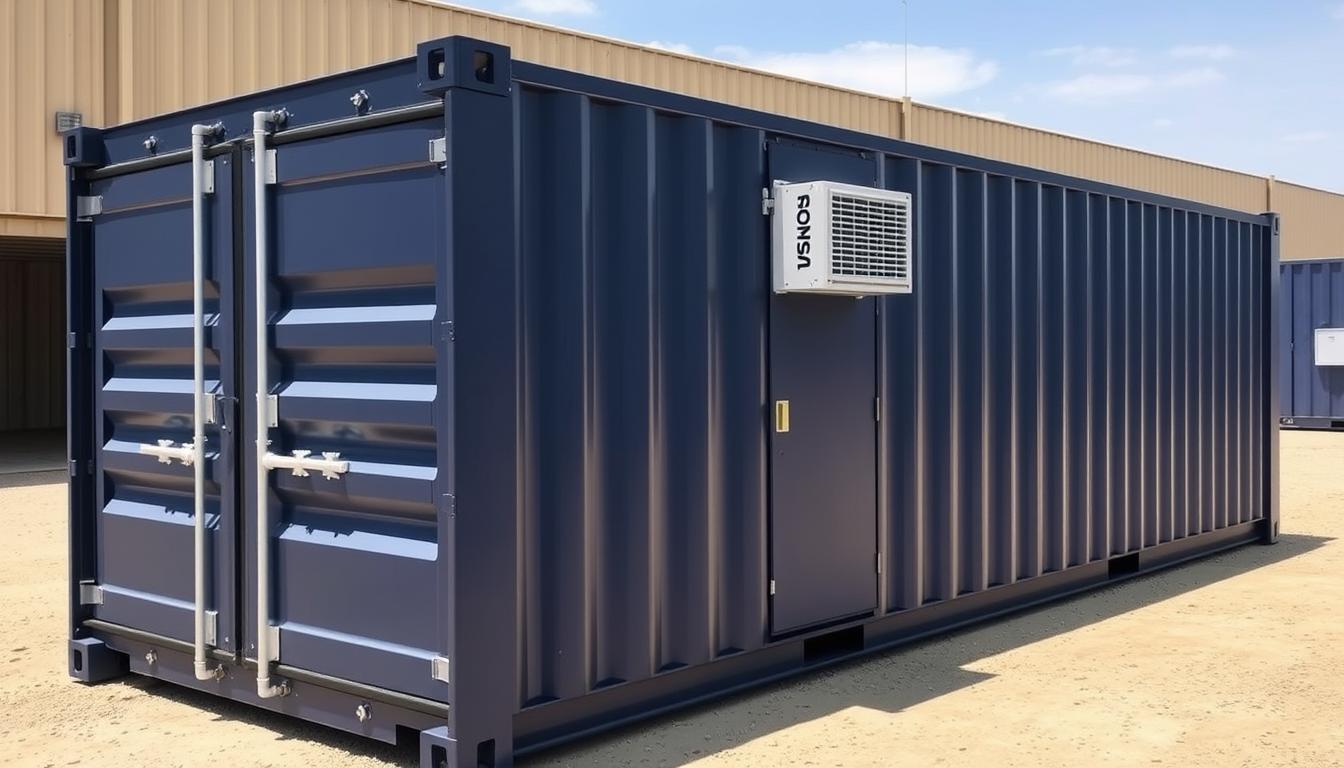Repurposing shipping containers into functional shooting ranges has revolutionized firearms training and recreational shooting. These innovative structures offer a perfect blend of affordability, mobility, and durability while meeting strict safety standards. Whether you’re a gun shop owner looking to expand services, a law enforcement agency needing dedicated training facilities, or an enthusiast wanting a private range, container-based shooting solutions provide versatile options for various needs.
This comprehensive guide explores everything you need to know about shipping container gun ranges – from initial design considerations to regulatory compliance and real-world implementation examples. We’ll walk through the entire process, helping you understand what makes these modular shooting ranges an increasingly popular alternative to traditional construction.
Key Benefits of Shipping Container Gun Ranges
Advantages of Container Ranges
- Cost-effective alternative to traditional construction (50-70% savings)
- Modular design allows for expansion and customization
- Portable and relocatable – can be moved to different locations
- Rapid deployment – operational within days, not months
- Durable steel construction provides excellent ballistic containment
- Weatherproof design functions in various environments
- Reduced permitting complexity compared to permanent structures
- Potential for off-grid operation with generator power
Cost-Effectiveness
The financial advantages of shipping container gun ranges cannot be overstated. Traditional indoor range construction typically costs $500,000 to $1,000,000 for a basic facility. In contrast, container-based ranges generally run between $100,000 and $250,000 depending on specifications and customization. This dramatic cost reduction makes professional-grade shooting facilities accessible to smaller businesses, clubs, and even dedicated individuals.
Portability and Flexibility
Unlike permanent structures, modular shooting ranges can be relocated as needed. This mobility provides significant advantages for businesses testing new markets, training programs requiring different locations, or property owners who may relocate in the future. Standard shipping container dimensions (typically 20ft, 40ft, or 53ft) make transportation straightforward using common shipping methods.

Customization Options
Modern container ranges offer extensive customization possibilities. From basic two-lane pistol setups to sophisticated multi-container rifle ranges with advanced target systems, these modular units can be tailored to specific training requirements. Common customization options include:
- Variable lane configurations (1-4 lanes per 40ft container)
- Ballistic rating options (pistol-rated vs. rifle-rated)
- Advanced target retrieval systems (static, turning, or programmable)
- Climate control systems for all-weather operation
- Sound suppression packages for noise reduction
- Control rooms and observation areas
- Custom exterior finishes and branding
Design Considerations for Shipping Container Gun Ranges
Creating an effective shipping container gun range requires careful planning and attention to several critical design elements. These considerations ensure safety, functionality, and compliance with applicable regulations.
Ventilation Systems
Proper air handling is perhaps the most critical safety component in any indoor shooting range. Container ranges require specialized ventilation systems that:
- Create downrange airflow (minimum 50 feet per minute across firing line)
- Incorporate HEPA filtration (99.97% efficiency at 0.3 microns)
- Maintain negative pressure inside the range
- Filter lead particles and gunshot residue before air exhaust
- Include appropriate monitoring systems
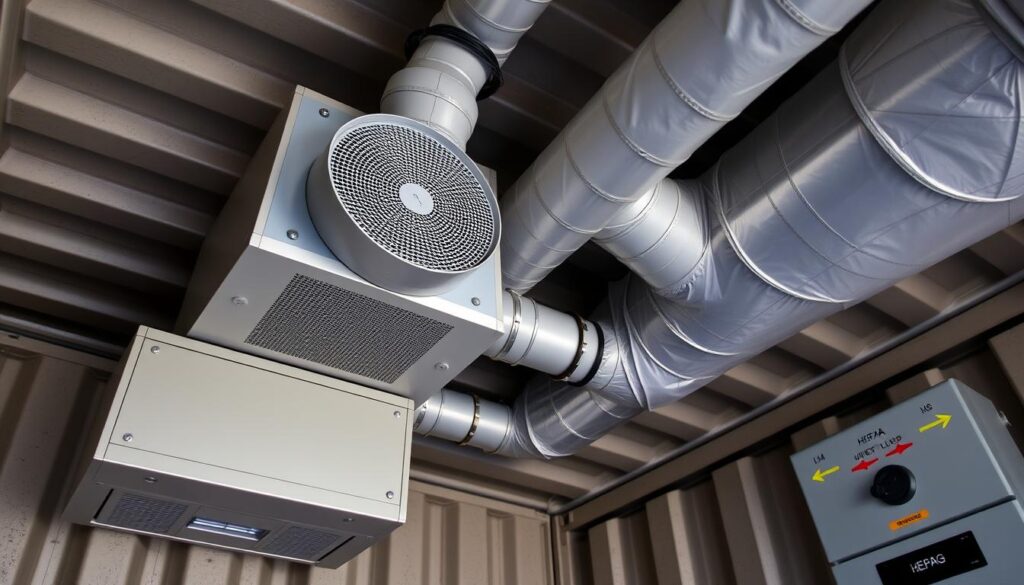
Soundproofing Solutions
Effective sound management is essential for both shooter comfort and environmental compliance. Container ranges typically incorporate:
- Acoustic foam panels (2-4 inches) on walls and ceiling
- Mass-loaded vinyl barriers within wall assemblies
- Rubber flooring for sound absorption
- Acoustic baffles in key areas
- Sealed entry doors with acoustic properties
Safety Features
Container ranges must incorporate comprehensive safety systems, including:
Ballistic Protection
- AR500/AR550 steel plate lining (3/8″ minimum for pistol, 1/2″ for rifle)
- Overlapping plate design to prevent bullet escape
- Fully armored ceiling, walls, and floors
Safety Systems
- Emergency lighting and exit signage
- Fire suppression systems
- First aid stations
- Communication systems
- Bullet traps with proper containment
Layout Examples
Container range layouts vary based on intended use and available space. Common configurations include:

Basic Single Container
40ft container with 2 shooting lanes, basic target retrieval, suitable for pistol calibers up to .44 Magnum. Ideal for small businesses and personal use.
Extended Rifle Range
Multiple connected containers creating 15-25 yard shooting distance, reinforced for rifle calibers up to .308 Winchester. Preferred by law enforcement and serious training facilities.
Tactical Training Setup
Wide-open container configuration with movable barricades, multiple target systems, and 360° ballistic protection. Designed for dynamic training scenarios.
Step-by-Step Setup Process
Implementing a shipping container gun range involves several key phases from initial planning through final operation. This systematic approach ensures a safe, compliant, and functional facility.
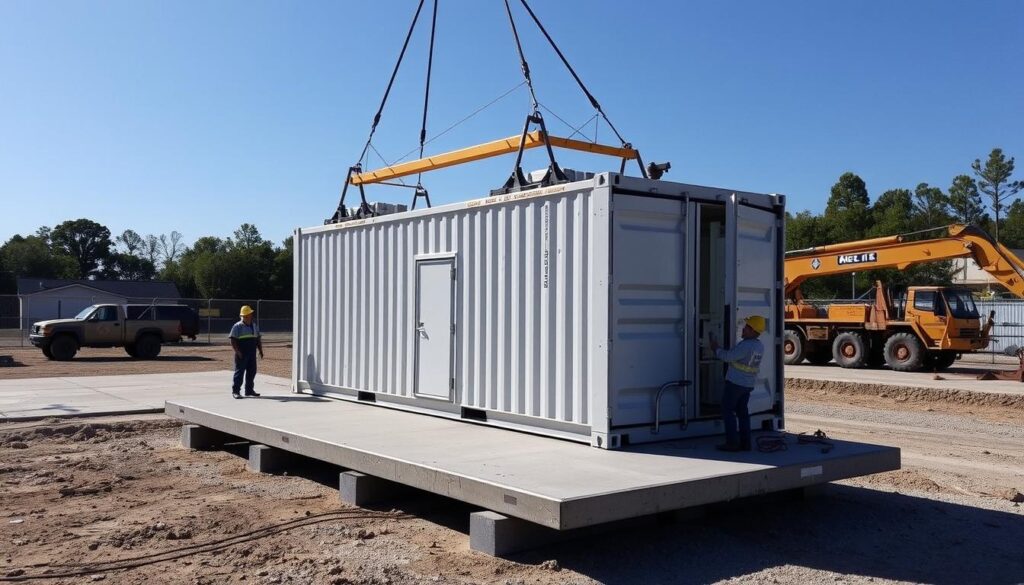
Permitting and Legal Requirements
Before beginning any construction, you’ll need to navigate various regulatory requirements:
- Research local zoning regulations for shooting ranges
- Consult with local building department about permits
- Prepare site plans and engineering documents
- Submit environmental impact assessments if required
- Obtain business licenses and insurance
- Schedule required inspections
Site Preparation
Proper site preparation is crucial for container range stability and functionality:
- Select level ground with appropriate drainage
- Prepare concrete pad (minimum 6″ reinforced concrete)
- Ensure adequate access for delivery vehicles
- Install utility connections (power, water if needed)
- Consider security fencing and access control

Container Modification Process
Converting shipping containers into functional ranges requires specialized modifications:
- Select appropriate container type (new vs. single-trip)
- Install interior framing and ballistic protection
- Add electrical systems and lighting
- Install ventilation and filtration equipment
- Apply soundproofing materials
- Create entry/exit points and emergency exits
- Install target systems and bullet traps
- Add final interior finishes and shooting stalls
Equipment Installation
The final phase involves installing specialized range equipment:
Essential Systems
- Target retrieval mechanisms
- Bullet trap and collection system
- Ventilation controls and monitoring
- Lighting systems (downrange and shooter areas)
Optional Enhancements
- Camera and recording systems
- Sound systems for commands
- Climate control equipment
- Shooting position equipment
- Control room technology
Legal and Safety Compliance
Operating a shipping container gun range requires adherence to various regulations and safety standards. Understanding these requirements is essential for legal operation and risk management.
Zoning and Local Regulations
Container ranges must comply with local zoning ordinances, which vary significantly by location:
- Industrial zones typically allow shooting ranges with fewer restrictions
- Commercial zones may require special use permits
- Residential areas generally prohibit ranges (exceptions for rural properties)
- Noise ordinances may restrict operating hours
- Some jurisdictions have specific distance requirements from schools, churches, etc.
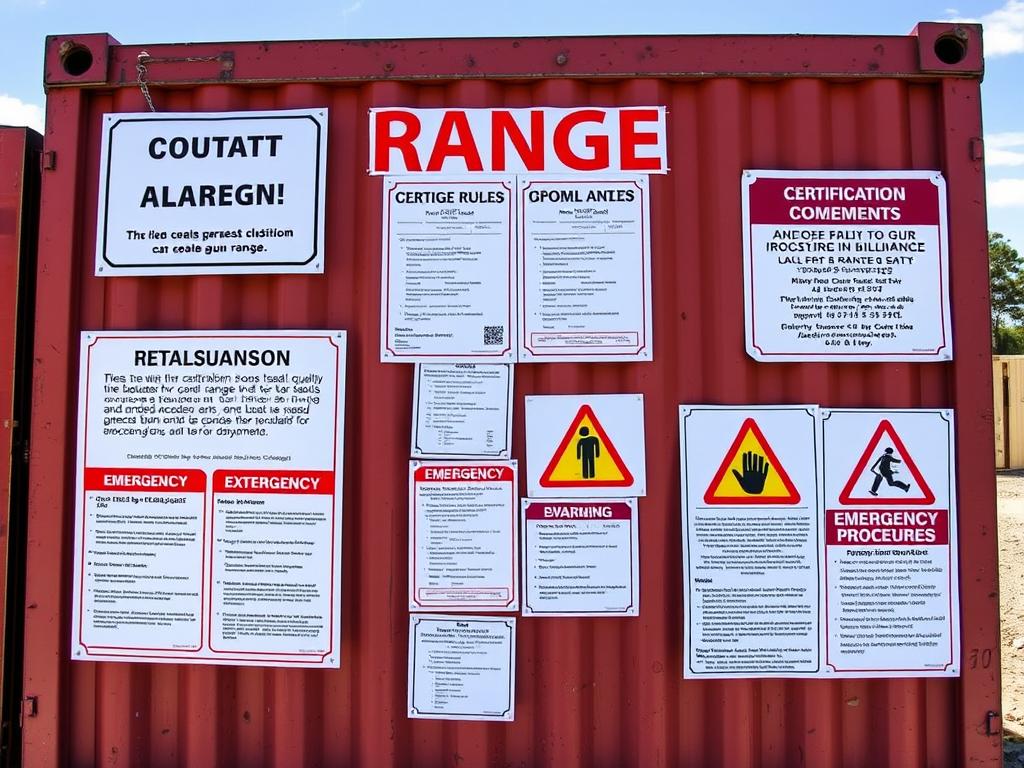
Insurance Requirements
Proper insurance coverage is essential for any shooting range operation:
- General liability insurance (minimum $1M recommended)
- Property insurance for the range structure and equipment
- Workers’ compensation if employing staff
- Professional liability for training operations
- Environmental liability coverage
OSHA and Environmental Regulations
Container ranges must meet workplace safety and environmental standards:
OSHA Requirements
- Lead exposure monitoring and control
- Proper ventilation systems
- Hearing protection protocols
- Emergency action plans
- Regular safety inspections
EPA Considerations
- Lead waste management and disposal
- Air quality and emissions standards
- Wastewater management (if applicable)
- Hazardous material handling procedures
ATF Regulations
If operating as a commercial range or offering firearm rentals, additional Bureau of Alcohol, Tobacco, Firearms and Explosives (ATF) regulations may apply:
- Federal Firearms License requirements
- Secure storage protocols
- Record-keeping requirements
- Background check procedures
Cost Analysis: Container Ranges vs. Traditional Construction
Understanding the financial implications of different range options helps in making informed investment decisions. This comparison highlights key cost factors between shipping container ranges and traditional construction.
| Cost Factor | Container Range | Traditional Construction |
| Initial Construction | $100,000 – $250,000 | $500,000 – $1,000,000+ |
| Construction Timeline | 4-12 weeks | 6-12 months |
| Permitting Costs | $2,000 – $5,000 | $10,000 – $30,000 |
| Annual Maintenance | $5,000 – $10,000 | $15,000 – $25,000 |
| Utility Costs | $300 – $600/month | $800 – $1,500/month |
| Relocation Possibility | $5,000 – $15,000 | Not possible |
Return on Investment Considerations
The ROI timeline for container ranges is typically much shorter than traditional construction:
- Commercial ranges can achieve ROI in 2-4 years (vs. 7-10 for traditional)
- Lower initial investment reduces financial risk
- Mobility allows relocation to more profitable areas if needed
- Modular expansion capabilities allow growth with demand
- Potential tax advantages (may qualify as equipment rather than real property)
Pro Tip: Many container range providers offer financing options, with monthly payments often lower than commercial lease rates for equivalent traditional range space.
Real-World Case Studies
Examining successful shipping container gun range implementations provides valuable insights into practical applications and outcomes. These case studies highlight different approaches to container range development.
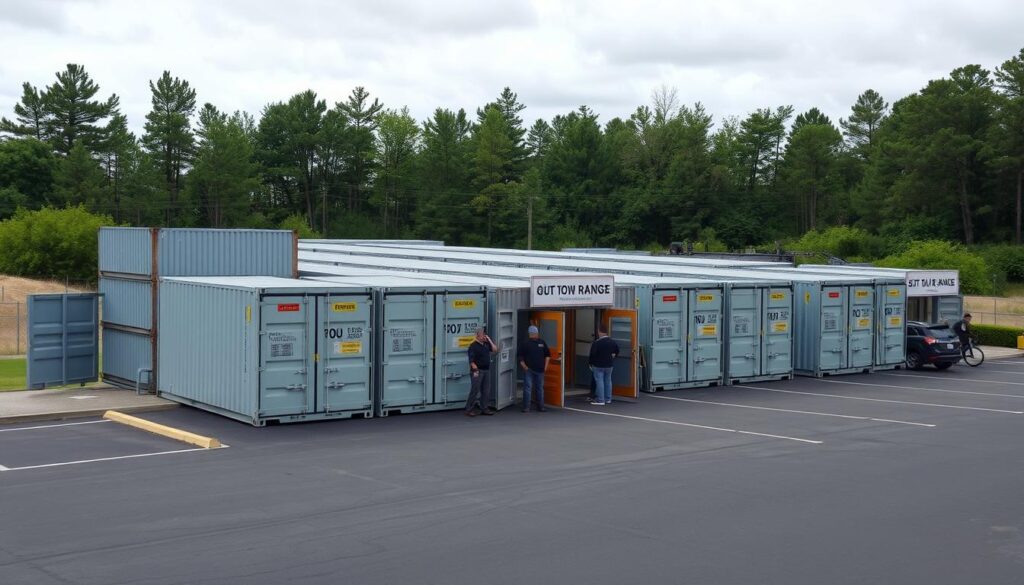
Case Study 1: Commercial Range Expansion
Precision Firearms Training Center
Configuration: Three 40ft containers joined to create a 6-lane pistol and rifle range
Dimensions: 40ft x 24ft (960 sq ft) total shooting area
Materials: Single-trip containers with AR500 steel lining, acoustic foam treatment
Key Features:
- Programmable target retrieval system with turning targets
- Climate-controlled environment for year-round operation
- Advanced HEPA filtration system exceeding EPA requirements
- Control room with video monitoring of all lanes
Results: Achieved 130% ROI within 18 months through membership fees and training classes. Reduced operating costs by 40% compared to their previous leased facility.
Case Study 2: Law Enforcement Training Facility
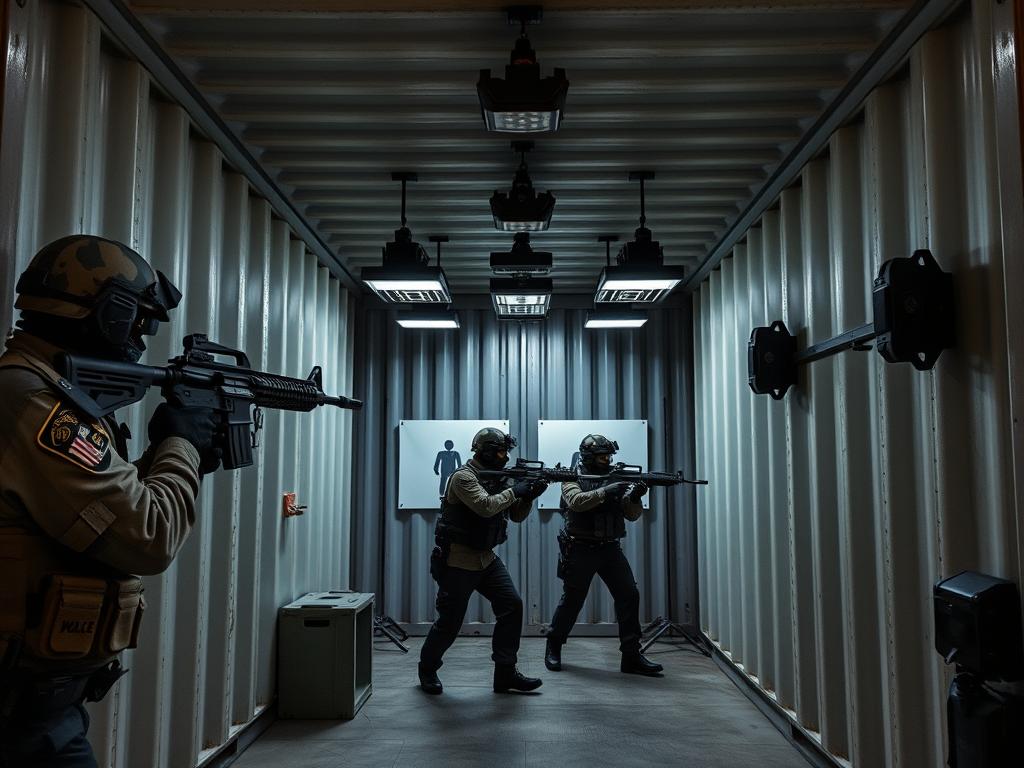
County Sheriff’s Department Training Range
Configuration: Four 53ft containers creating a 25-yard rifle-rated tactical range
Dimensions: 106ft x 16ft (1,696 sq ft) total training area
Materials: New containers with 1/2″ AR550 steel lining, rubber berm bullet trap
Key Features:
- Reconfigurable tactical training environment
- Simulated low-light and no-light training capabilities
- Integrated camera system for training review
- Ballistic rubber wall treatments for dynamic shooting scenarios
- Separate classroom container with video link to range
Results: Reduced annual training costs by 65% by eliminating travel to regional facilities. Increased training frequency from quarterly to monthly sessions.
Case Study 3: Private Enthusiast Range
Rural Property Owner’s Personal Range
Configuration: Single 40ft container modified for 2-lane pistol use
Dimensions: 40ft x 8ft (320 sq ft) shooting area
Materials: Used container with 3/8″ AR500 steel lining, basic sound treatment
Key Features:
- Manual target retrieval system
- Solar power with battery backup for off-grid operation
- Basic ventilation system with HEPA filtration
- Minimal exterior modifications to maintain low profile
Results: Created year-round shooting capability on private property while maintaining compliance with local ordinances. Total cost was approximately 30% of quotes for traditional construction.

Frequently Asked Questions
How many shooting lanes can fit in a 40ft shipping container?
A standard 40ft shipping container can accommodate 2-3 shooting lanes, depending on the width requirements. Most commercial setups use 2 lanes to provide comfortable shooting positions with adequate spacing. For tactical training with moving shooters, a single wide lane may be preferable. Larger facilities often connect multiple containers side-by-side to create additional lanes.
What types of firearms can be safely used in a shipping container gun range?
The firearms suitable for use depend on the specific ballistic rating of your container range. Standard pistol-rated ranges can typically handle calibers up to .44 Magnum. Rifle-rated ranges with enhanced ballistic protection and appropriate bullet traps can accommodate most common rifle calibers up to .308 Winchester (7.62×51mm NATO). Specialized high-power rifle ranges require additional reinforcement and are typically custom-built to specification.
What are the power requirements for a shipping container gun range?
Most standard container ranges require 50-amp single-phase electrical service (208-240V), similar to what’s used for RVs. This powers ventilation systems, lighting, target retrieval mechanisms, and climate control. Larger multi-container facilities may require three-phase power. Many ranges can also operate using appropriately sized generators (minimum 12kW) for remote locations or backup power.
How long does it take to set up a shipping container gun range?
Once permits are secured and the site is prepared, installation of a pre-fabricated container range typically takes 1-3 days. Custom builds with multiple containers may require 5-7 days for complete setup. The total timeline from order to operation usually ranges from 4-12 weeks, with most of this time dedicated to manufacturing and customization. This compares favorably to traditional range construction, which often takes 6-12 months.
What maintenance is required for a shipping container gun range?
Regular maintenance includes: 1) Changing pre-filters in the ventilation system every 30-60 days depending on usage; 2) Replacing HEPA filters annually; 3) Cleaning and maintaining the bullet trap system quarterly; 4) Inspecting ballistic surfaces for damage; 5) Servicing target retrieval systems according to manufacturer specifications; and 6) Conducting lead testing and cleanup procedures. Most manufacturers provide detailed maintenance schedules with their installations.
Conclusion
Shipping container gun ranges represent an innovative solution that balances cost-effectiveness, functionality, and compliance with safety standards. Their modular nature provides flexibility for various applications, from commercial enterprises to law enforcement training and private use. By understanding the design considerations, setup requirements, and regulatory landscape, you can make informed decisions about implementing this versatile shooting range option.
Whether you’re expanding a business, enhancing training capabilities, or creating a personal shooting facility, container-based ranges offer significant advantages over traditional construction. Their growing popularity reflects their practical benefits and adaptability to diverse needs in the firearms training and recreational shooting communities.

